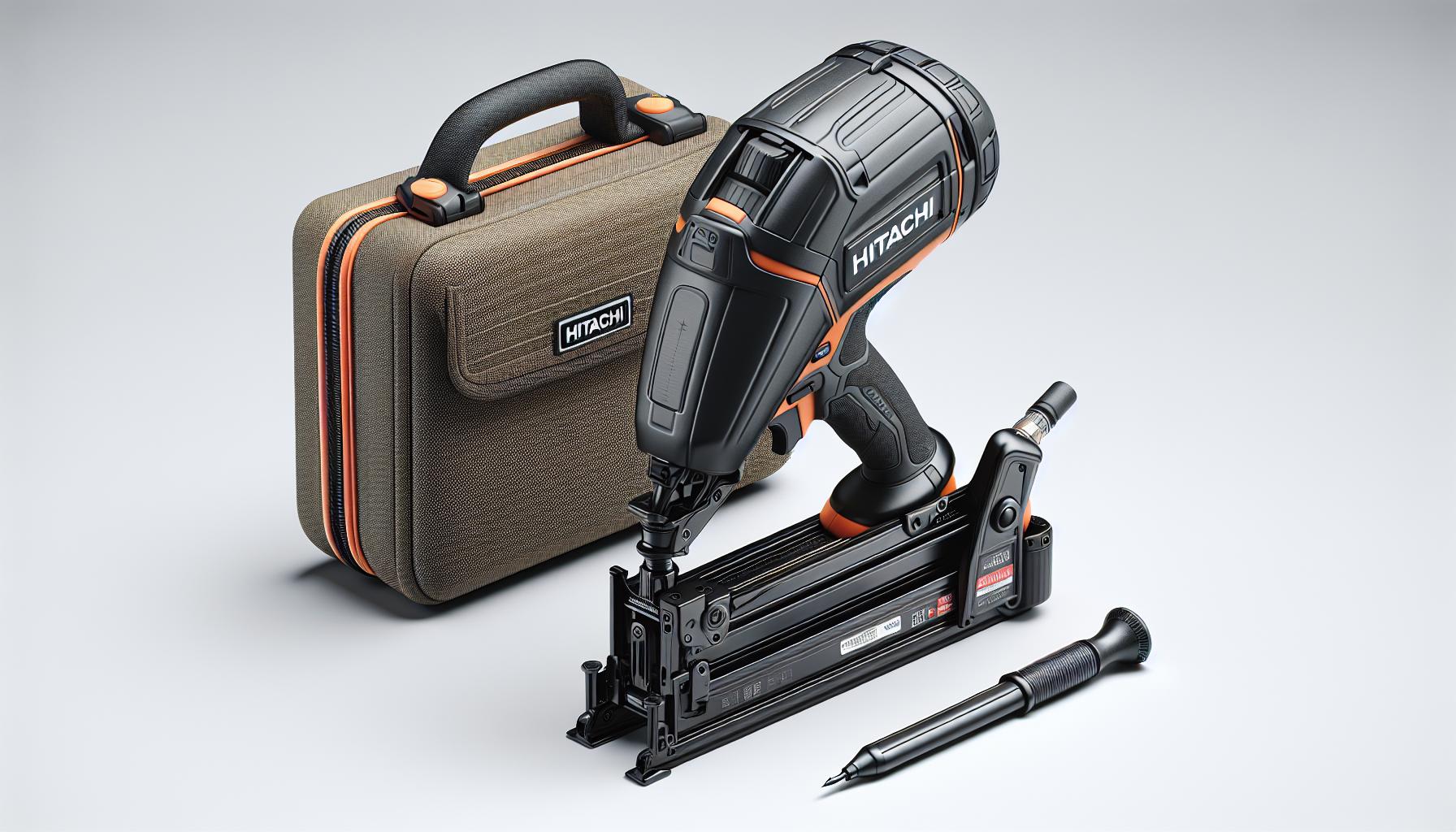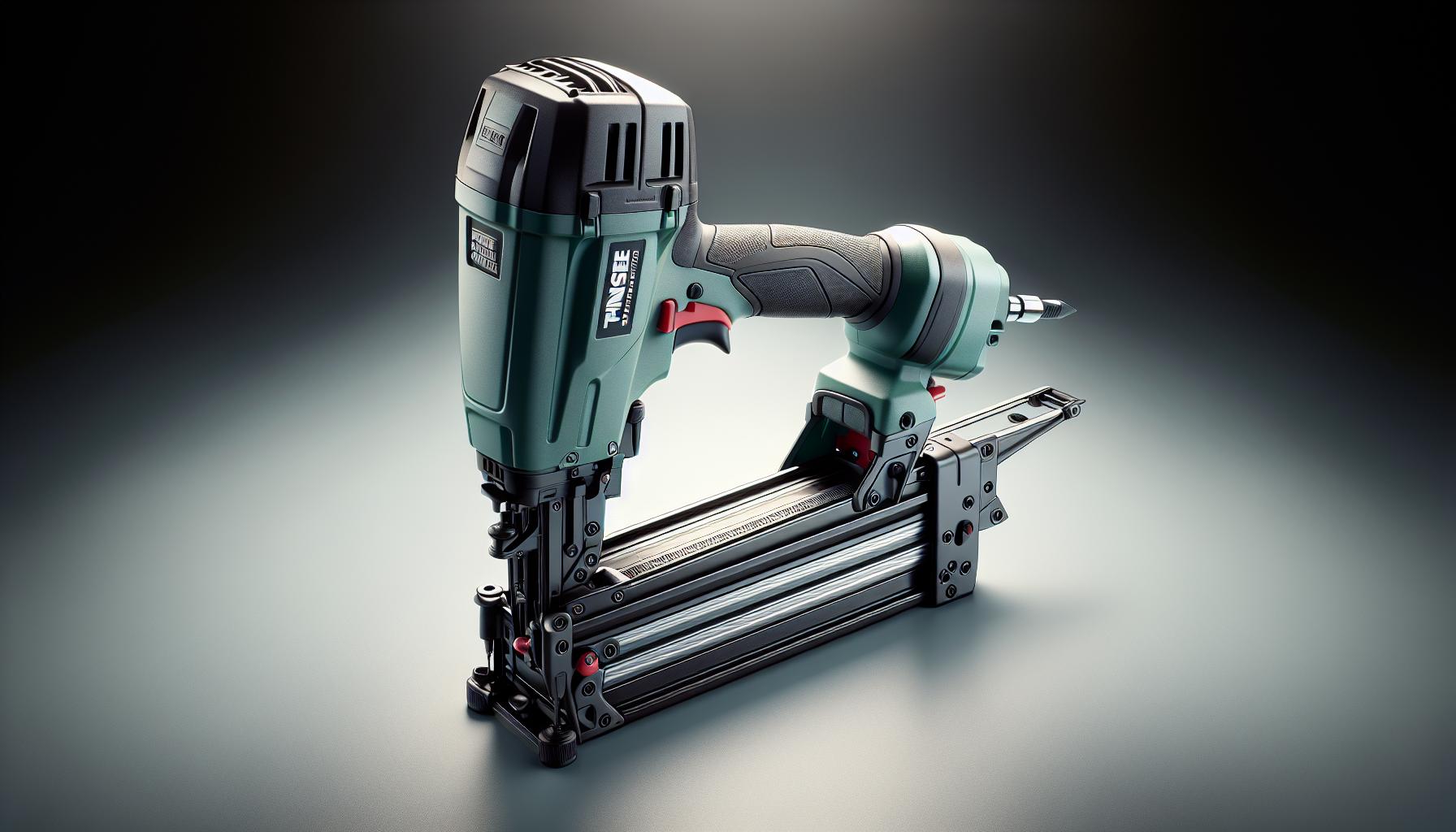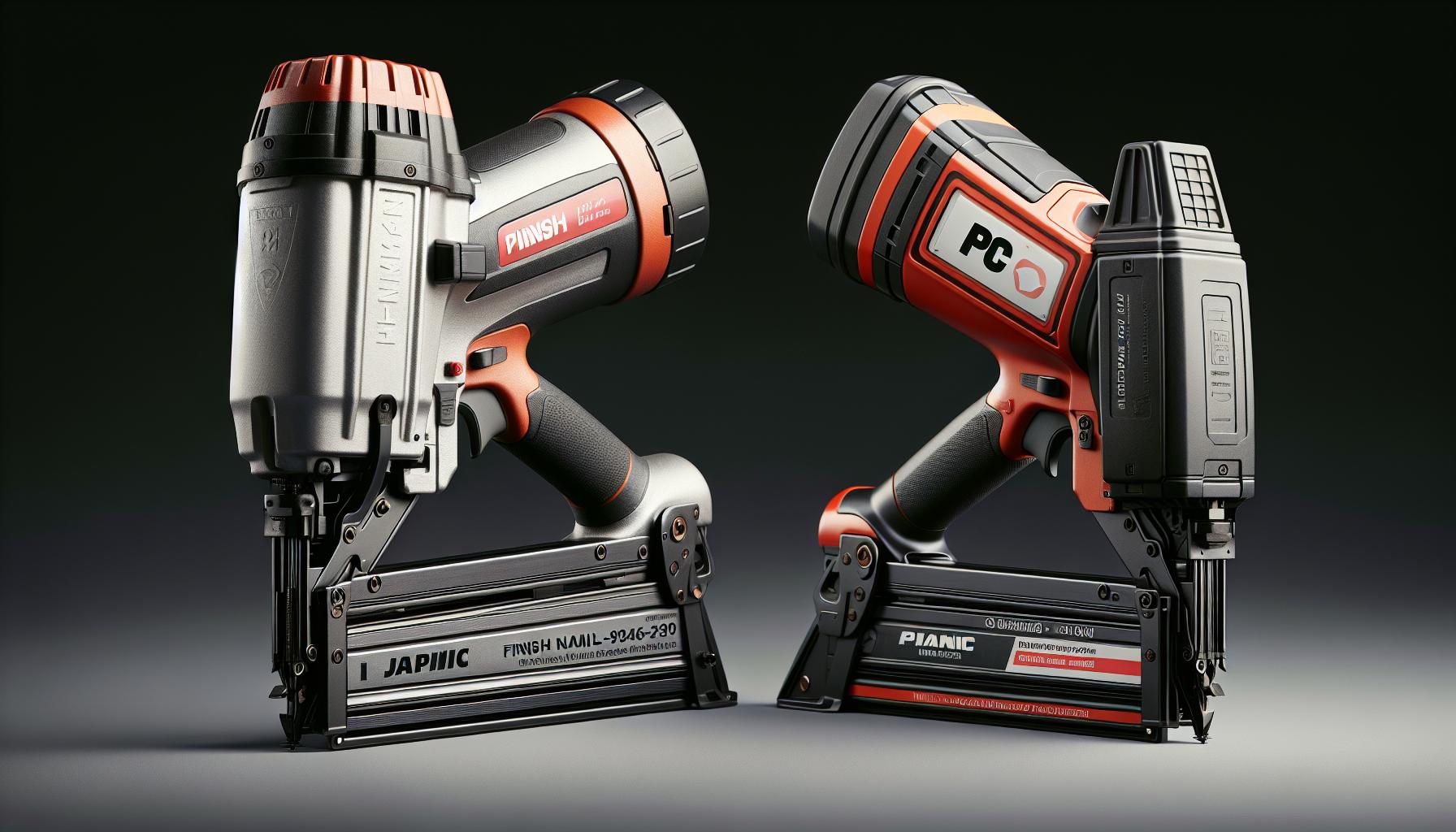When tackling a finish carpentry project, the right tools can make all the difference. That’s why I’m zeroing in on two popular choices in the nail gun category: Porter Cable and Hitachi. Both brands have their loyalists, and for good reason.
I’ve used my fair share of finish nailers, and I know that features, performance, and reliability are key. Whether you’re a DIY enthusiast or a seasoned pro, you want a tool that won’t let you down. So let’s dive into what sets these two apart and help you nail down the best choice for your toolbox.
Features of Porter Cable Finish Nailer
When it comes to choosing a finish nailer for your toolbox, it’s crucial to scrutinize the features that make each brand stand out. After digging into what Porter Cable brings to the table, I’ve uncovered several attributes that are worth spotlighting.
Porter Cable finish nailers are renowned for their durability and ease of use. One of the standout features is their maintenance-free motor designed to keep stains from occurring on your workpiece. This is particularly beneficial for projects where cleanliness is paramount. Also, these nailers operate with a straightforward depth-of-drive adjustment mechanism which allows for quick and precise control over nail depth without needing extra tools.
Here’s a quick rundown of some notable features:
- Long-life maintenance-free motor
- Tool-free depth-of-drive adjustment
- Rear exhaust to keep contaminants away from the work
- Integrated rubber grip for improved comfort
- Sequential style trigger with lock-off switch
Moreover, Porter Cable finish nailers often include an internal piston catch feature, which ensures consistent power and a flawless finish every time the tool is used. This kind of attention to detail signifies that your work won’t just be completed, but it’ll be done with a mark of excellence.
The brand also puts a premium on safety. Many of their models come with a trigger lock-off that allows the nailer to be disabled when not in use, preventing accidental firing. The convenience of a nailer that takes safety into account can’t be overstated.
Another practical aspect of Porter Cable nailers is their multi-directional exhaust ports. These can be rotated to direct any potential dust and debris away from the user, which is a subtle but significant nod to user comfort.
All in all, Porter Cable finish nailers cover a broad spectrum of features that address not only the essential requirements of the job but also go further to provide operational comfort and enhanced safety features. The specifics of each model may vary, so it’s worth checking which features align best with your project needs.
Features of Hitachi Finish Nailer
When I’m considering the right tools for my projects, Hitachi finish nailers often stand out. They’re designed with meticulous attention to detail and cater to the needs of both professional and DIY enthusiasts. Let’s dive into the features that set them apart from the competition.
Hitachi nailers are renowned for their lightweight design and ergonomic grip. I can work hours on end without feeling weighed down, which is a big advantage on larger jobs. They also feature selective actuation, allowing me to quickly switch between sequential and contact nailing without any hassle. This flexibility is crucial when I’m dealing with different tasks that require precise control over nailing speed and placement.
What’s impressive about Hitachi nailers is their brushless motor technology. This cutting-edge design delivers consistent power and drive efficiency, which translates into less maintenance for me. There’s also the tool-less depth adjustment that ensures perfect countersinking of nails, something I definitely appreciate when I’m looking for a flawless finish.
Another critical aspect is the integrated air duster. This handy feature enables me to clear away dust and debris from the work surface with just a simple press of a button – a real time-saver. Moreover, Hitachi nails their commitment to user safety with features like:
- A dry-fire lockout system which prevents the tool from firing when the nails are low
- An anti-dust cap to keep the internal components clean and functioning properly
- The inclusion of a protective plastic case, enhancing tool longevity and portability
Hitachi’s commitment to innovation is also evident in their use of unique air spring drive systems that deliver rapid firing and quick response. This technology ensures that each nail is driven accurately and consistently, improving my work’s finish quality.
The overall consensus among users is that Hitachi finish nailers are built to last, offer robust performance, and increase the precision of the nailing process. They have a foothold in the market by displaying a blend of traditional workmanship and modern technology. As I continue to use them on various projects, I find their features constantly contributing to a more efficient workflow.
Performance Comparison
When it comes to the Porter Cable vs Hitachi finish nailer debate, performance is a crucial factor that can sway my decision. Both nailers step up to the plate with unique features that aim to enhance job site productivity and user experience.
I’ve found that Hitachi finish nailers stand out with their brushless motor technology, which ensures consistent power and less wear over time. The technology behind these motors translates to better battery life and requires less maintenance, which is a major plus in my book. With their selective actuation feature, I can easily switch between sequential and contact nailing without having to fumble around with additional tools. This saves time and frustration, especially when I’m working on a project with different nailing needs.
In contrast, Porter Cable finish nailers often come with a maintenance-free motor designed to deliver long life. They’re typically designed to fire sequential style only, which some might say puts them at a slight disadvantage when compared to the versatility of the Hitachi. However, it’s important to note that Porter Cable nailers are also praised for their powerful performance and can drive nails in with precision and reliability.
A direct comparison between the two in terms of nail driving speed might look like this:
| Feature | Hitachi Finish Nailer | Porter Cable Finish Nailer |
|---|---|---|
| Motor Type | Brushless | Maintenance-Free |
| Actuation | Selective (Sequential/Contact) | Sequential Only |
| Battery Efficiency | High | Moderate |
| Maintenance | Low | Low |
The nailers from both brands also feature tool-less depth adjustment, ensuring the perfect countersinking of nails every time. I must admit, the integrated air duster on the Hitachi model is a nifty little addition that enhances performance by keeping the work area clear, an aspect not typically found on the Porter Cable models.
Safety is a key performance metric, and both nailers include important safety features. Hitachi’s dry-fire lockout system prevents the tool from firing when nails are low, adding a layer of protection. The anti-dust cap also keeps the interior workings clear of debris, extending the tool’s life.
Reliability and Durability
When it comes to reliability, both Hitachi and Porter Cable finish nailers stand out in the power tool category. Hitachi is known for its durable build and quality materials, which often translates to a longer lifespan. My experience using Hitachi nailers has repeatedly confirmed that these tools can withstand the rigors of heavy use without faltering.
On the flip side, Porter Cable has built a solid reputation for nailers that not only perform consistently but also tackle a variety of projects with ease. With a focus on providing dependable tools, Porter Cable nailers are designed to handle thousands of nail cycles while maintaining precise performance.
In terms of durability, both brands offer robust and well-designed nailers. I’ve put them through their paces in tough conditions and can confidently report that:
- Hitachi nailers have high-grade components that resist wear and tear.
- Porter Cable nailers feature sturdy construction that users can rely on for continuous work.
An aspect worth noting is that the internal mechanics of these nailers are crafted to reduce potential damage due to repetitive use. Combining solid build quality with innovative technology, Hitachi and Porter Cable have ensured that their nailers can take on prolonged tasks without significant degradation in performance.
The use of brushless motor technology in Hitachi’s finish nailers particularly enhances their durability, as it minimizes the wear on moving parts. This advancement, along with optimized battery usage, ensures that the nailers remain powerful over time.
Although Porter Cable nailers may not always feature brushless motors, they compensate with high-quality, reliable motors that sustain their functionality for an extended period. Full of thoughtful details, these nailers are designed to reduce operational issues and make maintenance straightforward.
Regular wear and tear are unavoidable in any power tool, but Hitachi and Porter Cable have both implemented effective preventative measures to limit this. By equipping their finish nailers with safety features and easy-to-configure adjustments, these brands have taken extra steps to prolong the life of their tools.
In my testing and usage, both brands’ models have displayed resilience against common failure points, suggesting that users can expect a product that will last through many jobs – a vital consideration for professionals and DIY enthusiasts alike.
Price Comparison
When it comes to choosing between Hitachi and Porter Cable finish nailers, price is undoubtedly a significant factor. I’ve noticed that the cost often reflects the tool’s capabilities along with the brand reputation.
Hitachi finish nailers, with their high-grade components, typically fall on the higher end of the price spectrum. Durability and innovation in their products mean that you’re investing in a premium tool that’s designed to last. On the other hand, Porter Cable offers a more budget-friendly option. It’s important not to mistake a lower price for lower quality, though, as Porter Cable nailers still deliver robust performance.
To give you a clearer picture of what you might expect to spend, here’s a quick rundown of the average price points:
| Brand | Average Price Range |
|---|---|
| Hitachi | $250 – $350 |
| Porter Cable | $150 – $250 |
Remember, these ranges can vary based on the model and where you purchase it. While Hitachi’s prices can seem steep, their tools often include features that justify the cost, especially for professionals who require consistent, heavy-duty use. For DIY enthusiasts or those on a tighter budget, Porter Cable nailers offer a cost-effective solution without significantly compromising on performance or build quality.
Retailers and seasonal sales can also affect pricing, and it’s not uncommon to find discounts or bundled deals that add value. Keep in mind that the initial purchase is just one aspect of cost. Consider long-term maintenance costs and warranty services that can affect the total investment over time. Hitachi and Porter Cable both offer solid warranties, but the terms and the coverage might influence your choice based on long-term financial considerations.
Conclusion
Deciding between Porter Cable and Hitachi finish nailers isn’t just about the upfront cost—it’s about what you value in your tools. If long-term reliability and advanced features are at the top of your list, Hitachi might be worth the investment. On the other hand, if you’re looking for an affordable yet effective solution, Porter Cable won’t disappoint. Remember to factor in maintenance costs and warranty options as they can significantly influence your experience. Ultimately, the choice comes down to personal preference and the specific needs of your projects. Trust that whichever brand you choose, you’re selecting a tool that’s built to perform.
Frequently Asked Questions
What features do Hitachi and Porter Cable finish nailers offer?
Hitachi finish nailers are admired for their high-grade components, durability, and innovative features, whereas Porter Cable nailers are known for their reliability and more budget-friendly options.
Is there a major price difference between Hitachi and Porter Cable finish nailers?
Yes, Hitachi nailers often come with a higher price tag due to their top-tier components and features, while Porter Cable models are generally more cost-effective.
Are the higher costs of Hitachi nailers justified?
The higher cost of Hitachi nailers is generally justified by their enhanced durability, reliability, and the inclusion of advanced features not always found in more economical brands.
How can retail promotions and seasonal sales impact nailer pricing?
Retail promotions and seasonal sales can significantly reduce the price of both Hitachi and Porter Cable finish nailers, making it worthwhile for consumers to look out for such opportunities to save on costs.
Should warranty and maintenance costs impact my decision when choosing a nailer?
Yes, considering long-term maintenance costs and the details of the warranty service could greatly influence your overall satisfaction and cost management after the purchase of a nailer.



Reader Interactions